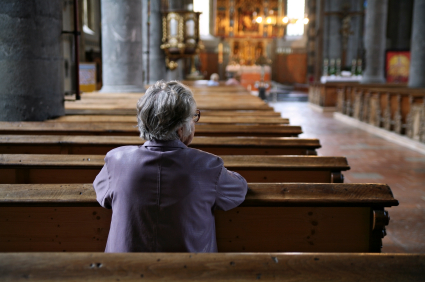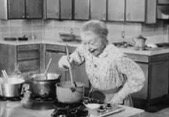Part 1 of 4: The Invisible Aging Person
 The church needs renewed consideration of the Eldest members. People too often become invisible once they are no longer able to get out, when they are too fragile to “contribute” to the growth or life of the church. I have witnessed a sad trend played out in congregations I have participated in and the work I have done with Elders both in the community and in Assisted Living Facilities. Once a person becomes absent – through relocation to an institution, becoming home bound due to infirmity or because the church is not set up to accommodate special needs – they become invisible. Deacons may send a card on special days. A church visitor may pop in for an hour once a month, but the Older member becomes exiled, wandering alone in the spiritual desert of their last years.
The church needs renewed consideration of the Eldest members. People too often become invisible once they are no longer able to get out, when they are too fragile to “contribute” to the growth or life of the church. I have witnessed a sad trend played out in congregations I have participated in and the work I have done with Elders both in the community and in Assisted Living Facilities. Once a person becomes absent – through relocation to an institution, becoming home bound due to infirmity or because the church is not set up to accommodate special needs – they become invisible. Deacons may send a card on special days. A church visitor may pop in for an hour once a month, but the Older member becomes exiled, wandering alone in the spiritual desert of their last years.
I belong to a small, aging congregation in a rural community. There has been discussion of late that if we don’t bring in younger families, the church may not have sufficient members to keep the doors open. That’s a reality shared by many small churches, and the focus of revitalization strategies taught by leaders like Thom Rainer and Ken Priddy. It makes sense: We must find ways to invite people to come in – and stay – to keep the church alive. The Great Commission calls us to make disciples and certainly we can’t do that if the doors are closed.
Historically, churches grew from the younger demographic upwards, not unlike societal institutions. Historically speaking (pre Baby Boomer cohort) the majority of our population were in their middle years, with a large base of youth and children at the base of the population pyramid, and retirees and Elders comprising the narrowing tip. Nursery care, preschool programs and Vacation Bible School drew families by attracting children and their parents. That was an effective paradigm for growth as the Boomer Generation was created, well into the 90’s as they then had their own children. (This format worked for me. I was “unchurched” until a program drew my children in and then I followed. Nothing softens the heart of a parent more thoroughly than seeing their children glowing with joy and a sense of purpose; the innocence of “letting their light shine”).
The times, though, they are a’changing. The Boomers will be launching the last of their babies shortly. The Generations X and Y and the Millennials will not likely reproduce in the numbers that the Boomers and their parents did. Church nurseries, I predict, will not host the numbers that were common 30 years ago.
I will close this installment with a story I was privy to. I began reflecting on this situation as our church discusses revitalization efforts and how we become more welcoming. It occurred to me to think through “to whom do we need to be welcoming?” We need to not overlook our aged church members, who once disconnected from their Spiritual fellowship, can suffer in isolation.
Mae was a resident at an assisted living where I was employed as a nurse. She was in her early 80’s, and suffered short term memory loss. Mae had been moved to the assisted living apartment because she could no longer safely care for herself at home, and her family thought the socialization of the community living facility would benefit her. Mae had a church visitor – once a month a young gentleman would “round” on about a half dozen residents who had once been church members. As far as I could see, that was her only church contact. In chatting with her eldest child one day, I heard an intense anger towards the church and it’s members, as he felt that for the 40 years Mae had participated in all aspects of the life of her church, no one “saw” her anymore. She had become invisible to the church family, save the dedicated volunteer who provided ministry in the local facilities for “former” church members. Mae was starving for conversation, for regular prayer, Bible Study, a friend, and the ritual of church services. In the assisted living, she was spiritually starving. Her children also felt abandoned by the church family they had grown up with, and thought would continue to be a resource for them and their mother as her needs changed.
Our seniors become “the forgotten” and often decline visits because “they don’t want to be a bother”. I’ll let you in on a secret. They DO want to be a bother. They want to be seen, noticed, cared about, included, even in their changing states. They thirst for authentic connection, visits, prayer, hymns, gossip.
Questions to consider:
How many of your aged church members seem to have become invisible once they no longer attended services regularly?
Is anyone designated in your church to notice an absence and follow up with a call to the parishioner or their family?
Who in your church family is tasked with making sure members, unable to get out often, are visited frequently enough to nurture still growing relationships, rituals and spiritual succor?
* * * * * * *
I challenge church leaders to take an inventory of the people that have faded from view in the last year.
Where have they gone?
Who has reached out to them?
What training is offered for your volunteer visitors, if you have such a body, so that they are equipped to have meaningful visits to those who are home bound?
Does your church regularly engage with the families of their aging membership?

 Contemplating issues facing the aging population on our planet (and therefore, facing us all) I became aware of the lack of positive role models for active aging and co-generational caring in families. In the US, where people over 60 are more than 30% of the population, only 2% of movie and television roles portray older adults, and then often in cameo/comedic roles.. What does this lack of role modeling mean for us? That we don’t have a strong cultural idea – coming out of the “nuclear family” post WWII era – regarding the needs of our Elders for meaningful relationships with younger adults and conversely, the need for all of us to “mind our elders.” Culturally, we lack a map for what healthy, positive co-generational sharing should look like, and how to live it out.
Contemplating issues facing the aging population on our planet (and therefore, facing us all) I became aware of the lack of positive role models for active aging and co-generational caring in families. In the US, where people over 60 are more than 30% of the population, only 2% of movie and television roles portray older adults, and then often in cameo/comedic roles.. What does this lack of role modeling mean for us? That we don’t have a strong cultural idea – coming out of the “nuclear family” post WWII era – regarding the needs of our Elders for meaningful relationships with younger adults and conversely, the need for all of us to “mind our elders.” Culturally, we lack a map for what healthy, positive co-generational sharing should look like, and how to live it out.